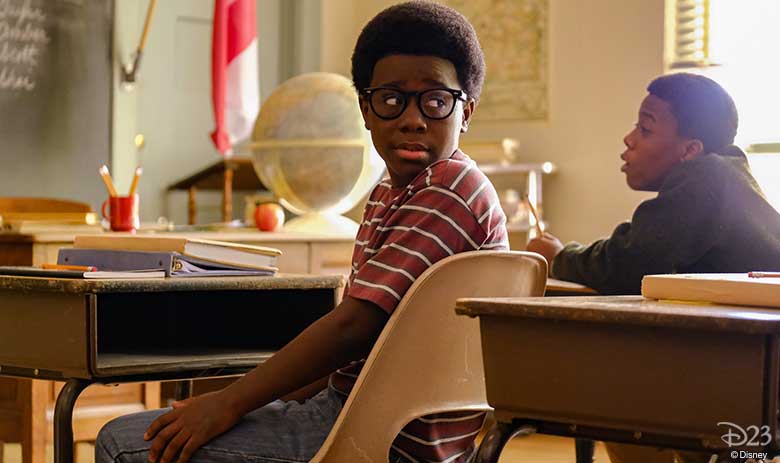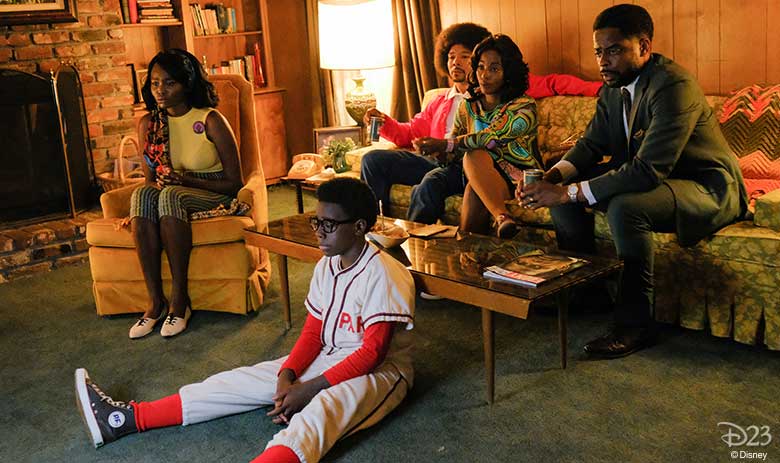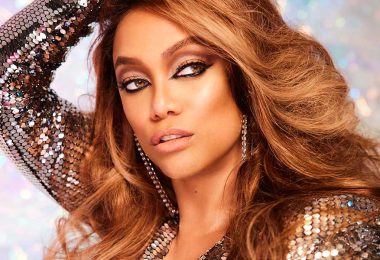By Zach Johnson
The Wonder Years may be a fictional series, but in many ways, it’s also a time capsule of America 50+ years ago. Inspired by the beloved and award-winning series of the same name, the new original coming-of-age comedy follows the Williams family in the late 1960s, told from the perspective of imaginative 12-year-old Dean (Elisha “EJ” Williams). The Wonder Years joins ABC’s comedy night lineup tonight at 8:30 p.m. ET/PT, with a cast that includes Dulé Hill as Bill Williams, Saycon Sengbloh as Lillian Williams, and Laura Kariuki as Kim Williams, with Don Cheadle narrating each episode as Adult Dean Williams.
With the wisdom of his adult years, Dean’s hopeful and humorous recollections depict the ups and downs of growing up in a Black middle-class family in Montgomery, Alabama. To ensure that The Wonder Years accurately reflected its specific location and time, production designer Aiyana Trotter researched catalogs, films, magazines, photographs, and more from that period. “A lot of what was fashionable then looks kitschy and odd to us now,” says Trotter. Not wanting to make the Williams’ home “a parody of the ’60s,” Trotter says she looked for ways to make it genuine but subtle. “There isn’t much documentation of real homes of Black families in the ’60s,” she says, “so we were more dependent on the work or photojournalism and private photo collections… In the end, I had to find that balance so that the Williams family home feels familiar to us, like memories of our grandma’s house.”

Both the Williams family home and Dean’s school were constructed on a soundstage, which meant they literally had to design each set from the ground up. “We had to source everything: the construction materials, set dressing and props,” says Trotter. Set decorator Andrea Doyle bought fabrics from the ’60s and “created window dressing, bedspreads, and upholstered furniture with it,” she adds, while the set decoration team “scoured three states to find the period furniture, lighting, kitchenware, toys, games, picture frames, etc.”
Meanwhile, costumer designer Ceci’s creative journey began with mining her own life experiences, as well as those of her family and friends. “I have a treasure trove of family photos and a library of popular magazines from the ’60s that really transported me back to that time period,” she says. “My mom and dad are really my true inspirations. They both exposed me to the rudiments of fashion, style, fabrication, construction. and so much more.” Clothing from that era is distinguished by “bold colors, playful prints, textured textiles, and silhouettes that range from mod to sophisticated elegance,” says Ceci. “The costumes visually tell the story of each character as intended by the producers and writers. I think they support their narratives and speak for themselves.” Indeed, according to several of the actors, Ceci’s contributions proved invaluable in helping them get into character. “I’ve always been a fan of the style from the ’60s, because back then, everything mattered,” says Hill. “Walking out the door you made a statement: the way you had your hair made a statement, the suit you had on made a statement. Somewhere along the way, we may have lost that. I like the idea of looking back on that and hopefully reinvigorating that mindset.”

“The thing I’ll probably never get over is how tight those pants are!” Williams says. “Every time period has its own unique way of doing things, and this is how it was done in the ’60s.”
Although it’s a scripted comedy series, The Wonder Years is set against the backdrop of real events from American history. “We will not shy away from showing how the events of the time would have really affected a Black family as a unit, and affected the individual members, living in Alabama in the ’60s,” explains showrunner Saladin K. Patterson, who executive produces the series alongside Lee Daniels, Fred Savage, and Marc Velez. “By leaning on personal stories from family members and using those as the basis for how our characters would react/behave, we can organically weave the events into our narrative.”
That said, The Wonder Years is first and foremost a comedy series. “Lee Daniels and I feel that the experiences of the Black middle-class during the late ’60s have not been explored in TV and film,” Patterson says. “We have seen them explored for other decades, but usually the late ’60s are seen through the perspective of the ‘struggle.’ While that is a very important part of the Black experience, we feel there are other valuable perspectives that an audience would relate to.” Although The Wonder Years is set in the past, many of its themes remain relevant as ever. “If we can look at the turbulent, divisive late ’60s as ‘wonder years,’ then one day, a future generation will look at the 2020s as their ‘wonder years,’” he says. “That means we can have hope that the turbulent, divisive issues of today will be solved in our collective future—just like they were solved in our collective past.”





